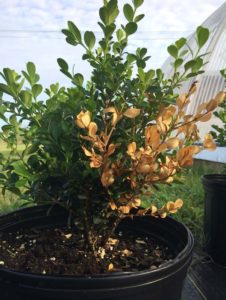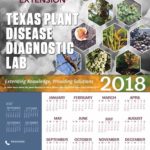 Boxwood dieback on Japanese boxwood (Buxus microphylla)
Boxwood dieback on Japanese boxwood (Buxus microphylla)
SCIENTIFIC NAME of causal agent: Colletotrichum theobromicola
DISEASE DESCRIPTION
SYMPTOMS:
The most characteristic symptoms of this disease are randomly distributed, tan-colored dead twigs and branches. Distinct black discoloration can be seen underneath the bark when it is removed on the dead tissues. The root system and crown (lower stem) of affected plants remain unaffected.
BIOLOGY:
English, Korean, and Japanese boxwoods are very susceptible to this disease. The pathogen is spread into new locations on infected nursery stock. Once introduced into the landscape, spores of the pathogen are produced on the infected twigs. These spores are then spread by splashing rain and overhead irrigation water. Poor pruning seems to be associated with disease development, possibly through the infection of pruning cuts. Precise environmental conditions that are conducive to disease development are not yet known.
MANAGEMENT METHODS:
Healthy nursery plants should be selected for landscape plantings. Proper diagnosis is critical to distinguish boxwood dieback from diseases with similar symptoms, such as Phytophthora root rot. If found in the landscape, then diseased boxwood plants should be removed and destroyed. Pruning tools used on diseased plants should be disinfested with a 10% bleach solution. Wounding of plants should be minimized.
RESOURCE LINKS:
https://apsjournals.apsnet.org/doi/full/10.1094/PDIS-06-17-0821-PDN
https://www.plantmanagementnetwork.org/sub/php/volume18/number3/PHP-04-17-0024-DG.pdf
Authored by Dr. David Appel, Professor & Extension Specialist
